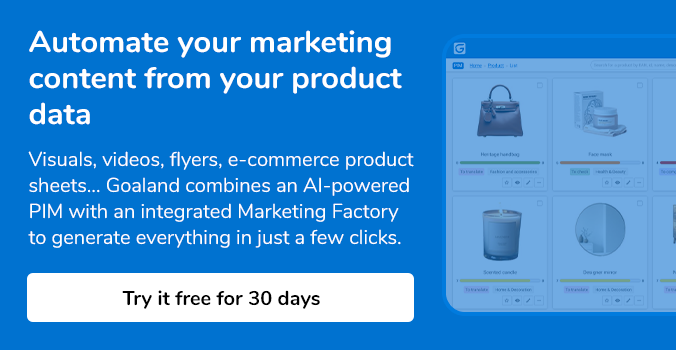The Digital Product Passport or DPP is a requirement of several regulations under the European Union's Circular Economy Action Plan (CEAP) which is a set of ambitious objectives for achieving carbon neutrality1 by 2050.
Depending on product categories, the DPP will progressively come into effect starting in 20272 and aims to achieve numerous objectives: reduce waste production, prolong product lifespans, promote repairability and durability…
While the DPP is a fantastic opportunity for businesses to integrate ecodesign criteria in their global strategy, it also comes as a challenge. Its implementation will require optimal management of all product-related data such as origins, composition, repair options, or technical characteristics…
This is why it is important for businesses to begin looking into solutions such as PIM (Product Information Management) for better storage, organization and sharing of product-related data.
Read the definition of the Digital Product Passport (DPP) and how PIM can be used in its implementation.
#Definition of Digital Product Passport (DPP)
#The Digital Product Passport, proof of ecodesign
Ecodesign is an approach to designing products and services that gives special consideration to the environmental impacts of the product over its entire lifecycle.

On March 30, 2022, the European Commission adopted the Ecodesign for Sustainable Products Regulation (ESPR) which builds on the energy related directive for ecodesign of products and introduces a brand-new measure: the Digital Product Passport or DPP.
The ESPR expands the scope of the types of products impacted by ecodesign, and the ecodesign criteria themselves: reuse possibilities, durability and reliability, energy efficiency, environmental footprint… Delegated acts will progressively complete the regulation, with more details on its implementation sector by sector. The European Commission's ambition is to determine around 20 acts by 2030.
#What is the DPP?
The Digital Product Passport is a new tool which will facilitate the transition towards a circular economy by collecting, recording, processing and sharing product-related information: origins, composition, options for repair and recycling…
The DPP makes this information accessible electronically through « a data carrier » within the value chain that includes producers, distributors, consumers, repairers, recyclers…
To simplify the future implementation of the Digital Product Passport within companies, the international organization GS1* is working on the definition of specific circularity application standards and is inviting organizations desirous to contribute to « future standards3 » to join an open international working group. Within this interest group, businesses can discuss topics related to the development and implementation of the regulations around the forthcoming DPP.
*GS1 is a not for profit, neutral organization, founded by businesses over 50 years ago. Its aim is to facilitate and automate exchanges between business partners through a unique, world‑renowned and widely used identification system. #Which products are impacted by the DPP?
The Digital Product Passport will aim to establish a standardized international register of product data, with a field of application predefined by the European Commission depending on specific product categories. The list of categories has not yet been finalized by the European Commission. However an initial analysis published by the Joint Research Center indicates a priority focus on the following industries: batteries, textile, electronics, and construction.
#What information should the DPP contain?
The Digital Product Passport will require businesses to manage large volumes of data relating to products and their components. This will involve two types of data:
- Static data which does not change during the product's lifecycle. This would include name, composition, repairability score, technical characteristics, environmental footprint...
- Dynamic data which will change over time, such as the capacity of a battery, its performance, or any repair operations.
PIM: manage the information contained in the DPP optimally
#Rely on a unique product repository
Very often, static and dynamic data is scattered across various company information sources: ERP (Enterprise Resource Planning), PLM (Product Lifecycle Management), files in various formats (Excel, XML, Json…).
With PIM you can gather and centralize this data in a unique product repository and federate all the different stakeholders in the value chain (suppliers, manufacturers, distributors…) around a unique source of truth. PIM also provides different levels of access depending on each profile.
This means that the data contained in the DPP is stored in a single system which guarantees its quality and secures its access.
#Update information quickly and easily
Dynamic data can be updated throughout the product lifecycle: capacities, resistance, lifespan… which means that businesses must update this data regularly.
PIM solutions make the process of updating dynamic data easy. Through a unique, user‑friendly interface, the various stakeholders can make changes to data quickly and easily. User rights and workflow features also allow you to check that information is up to date prior to validation.

These efforts in updating data increase a businesses' transparency in the implementation of the DPP. At any time, they can provide shoppers with reliable and complete information to help them make an informed purchasing decision.
#Unify your data under shared standards
All product-related data must be structured and compliant with European norms. When you are processing large volumes of data, this task can be tedious and time consuming.
PIM solutions optimize this homogenization effort as they structure and unify raw data coming from various information sources according to shared standards: naming rules, units of measure, structure… The PIM solution also ensures that each stakeholder respects the data formatting rules.
This standardization of data is essential for the implementation of the DPP. It will avoid any legal risks of non-compliance and simplify the jobs of the public authorities in inspecting and checking that the information complies with European standards.
#Easily enrich product information
The DPP acts like your « product log4 » tracking all the repairs or maintenance operations carried out on a product throughout its lifecycle. For a business this will require progressively enriching the information contained in the DPP.
PIM solutions optimize the data enrichment process. PIM comes with multi-user management features which ensure the cohesion between the various stakeholders during this phase. Depending on their user rights, each person can enrich information with data on repairs, recycling, maintenance…
As such, the different stakeholders can trace the origins and key components of the product, access the right information to optimize recycling, maintenance and repairs, and better contribute to the circular economy which is one of the main objectives of the DPP.
To sum up, PIM enables you to control the information required for the implementation of the digital passport in your business: storage, centralization, secured access, sharing… It is equipped with advanced features (centralization, management of access rights and workflow, multi-user administration…) to guarantee the compliance of product-related data with ecodesign regulations.
1
Pacte vert pour l'Europe. (2024, March 21). consilium.europa.eu/fr.
2
CIRPASS. (2024, February 7). State of play and possible future developments of the Digital Product Passport (DPP).
3
GS1. Passeport numérique des produits. gs1.fr.
4
Blonk, E. (2023, December 8). BIS Summit : les principaux enseignements de ce grand évènement pour les acteurs de la construction.






